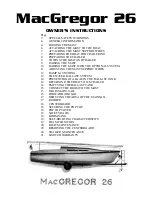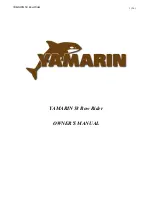
4
Chapter 2
Posted speed limits, swimming areas, “no wake” zones
and other restrictions should be red-fl agged. Th
ey are
so noted for a reason. Sensible boat use, plus courtesy,
equals enjoyable and safe boating.
It is your responsibility to stay abreast of all federal, state
and local rules, as some laws or regulations may change
or be diff erent from state to state. Contact your local
boating agencies for updated information.
We can not stress safety enough! Remember, there are
no brakes on your boat, and the water current and wind
velocity both aff ect your ability to respond. Th
e operator
must use caution at all times to maintain control of his
vessel and especially to keep a safe distance from other
boats and obstacles.
Always keep all safety gear in optimum condition. Pay
special attention to attached tags and plates indicating
expiration dates on equipment such as fi re extinguishers,
and personal fl otation devices. Encourage a periodic
maintenance check on all safety equipment. Contact your
Regal dealer or marine professional for more information.
Again, remember that the captain is responsible for his
crew, passengers and vessel.
PERSONAL FLOTATION DEVICES
All personal fl otation devices (PFD’s) must be Coast
Guard approved, in good working condition, and must
be the correct size for the wearer. All PFD’s must be
readily accessible. Th
is means being able to wear them
in a reasonable amount of time in case of an emergency
(fi re, boat sinking, etc.). Th
ey should not be stored or
locked in closed areas. Also, make sure that all coverings
are removed such as plastic from any PFD’s. Th
rowable
devices such as a ring buoy need to be available for
immediate deployment. A PFD should be worn at all
times when your boat is operating on the water. A PFD
may save your life, but it must be worn to do so.
As a minimum U. S. Coast Guard requirement all
recreational boats must carry one type I, II, III, or V PFD
(wearable) for each person aboard. See the explaination
following for each type. For type V to be counted they
must be used according to the label instructions. In
addition, all boats over 16’ must carry one Type IV
(throwable) PFD.
Some states require that PFD’s be worn by children of
specifi c ages at all times. Check with local and state
boating agencies for particular requirements in your state
before taking children on the water. Child life jackets
are classifi ed by the child’s weight and should like all life
jackets be sized before being purchased.
Remember PFD’s will not necessarily keep you from
drowning, even though they are designed to keep a person
from sinking. When purchasing PFD’s make sure it safely
fi ts the person wearing it. It is a good idea to test PFD’s in
a lifeguarded shallow pool before venturing on the water.
REQUIRED SAFETY EQUIPMENT
Содержание 42 Fly-Grande Coupe
Страница 1: ......
Страница 6: ...Table Of Contents...
Страница 20: ...14 Chapter 1 Note...
Страница 31: ...11 Safety On Board NAVIGATION LIGHT RULES...
Страница 52: ...9 Rules Of The Road...
Страница 53: ...10 Chapter 3...
Страница 78: ...25 Systems TYPICAL BATTERY MANAGEMENT SYSTEM VSR...
Страница 99: ...46 Chapter 4 TYPICAL AC ELCI CIRCUITRY FLOW CHART...
Страница 174: ...15 Engine Controls AFT FORWARD SIDEWAYS DIAGONALLY ROTATE JOYSTICK FUNCTIONS...
Страница 239: ...47 Auxiliary Equipment Operation 1 When voltage is initalized at the Gyro Control Box a splash screen will be shown...
Страница 240: ...48 Chapter 7...
Страница 241: ...49 Auxiliary Equipment Operation...
Страница 242: ...50 Chapter 7 SEAKEEPER SPECIFICATIONS...
Страница 267: ...21 Cosmetic Care Maintenance OVERBOARD DISCHARGE PAN DRAIN TYPICAL VECTOR COMPACT AC SYSTEM AIR FILTER...
Страница 281: ...35 Cosmetic Care Maintenance TYPICAL DIESEL GENERATOR PARTS DESCRIPTION...
Страница 282: ...36 Chapter 8...
Страница 300: ...54 Chapter 8 VOLVO IPS ENGINE DRIVE COMMON PARTS IDENTIFICATION...
Страница 323: ...10 Chapter 10 SHORE CABLE SYSTEM...
Страница 328: ...15 Troubleshooting TYPICAL WINDLASS...
Страница 347: ...6 Chapter 13 TECHNICAL DRAWINGS...
Страница 349: ...Technical Information 12 8 42 GRANDE COUPE FLY ELECTRICAL OULLETS...
Страница 350: ...Technical Information 12 9 TYPICAL DC GROUND CIRCUITRY...
Страница 351: ...Technical Information 12 10 TYPICAL BATTERY MANAGEMENT PANEL CIRCUITRY...
Страница 352: ...Technical Information 12 11 TYPICAL GFCI CIRCUITRY...
Страница 353: ...Technical Information 12 12 TYPICAL FIRE EXTINGUISHER GROUND CIRCUITRY...
Страница 354: ...Technical Information 12 13 TYPICAL TWIN VOLVO DIESEL ENGINE FIRE EXT SHUTDOWN...
Страница 355: ...Technical Information 12 14 TYPICAL BATTERY SWITCH CIRCUITRY...
Страница 356: ...Technical Information 12 15 TYPICAL WIPER CIRCUITRY OVERVIEW...
Страница 358: ...Technical Information 12 17 42 FLY UPPER HELM SWITCH PANEL...
Страница 359: ...Technical Information 12 18 42 FLY UPPER HELM SWITCH PANEL...
Страница 360: ...Technical Information 12 19 42 FLY UPPER HELM BREAKER PANEL...
Страница 361: ...Technical Information 12 20 42 GRANDE COUPE FLY LOWER HELM SWITCH PANEL...
Страница 362: ...Technical Information 12 21 42 GRANDE COUPE FLY LOWER HELM SWITCH PANEL...
Страница 363: ...Technical Information 12 22 42 GRANDE COUPE FLY EUROPEAN 230 VOLT AC PANEL...
Страница 364: ...Technical Information 12 23 42 GRANDE COUPE FLY EUROPEAN 230 VOLT AC PANEL AFT VIEW...
Страница 365: ...Technical Information 12 24 42 GRANDE COUPE FLY 120 240 VOLT AC PANEL...
Страница 366: ...Technical Information 12 25 42 GRANDE COUPE FLY 120 240 VOLT AC PANEL...
Страница 367: ...Technical Information 12 26 42 GRANDE COUPE FLY 12 VOLT DC PANEL...
Страница 368: ...Technical Information 12 27 42 GRANDE COUPE FLY 12 VOLT DC PANEL AFT VIEW...
Страница 370: ...Technical Information 12 29 42 GRANDE COUPE FLY AIR CONDITIONING SYSTEM OVERVIEW...
















































